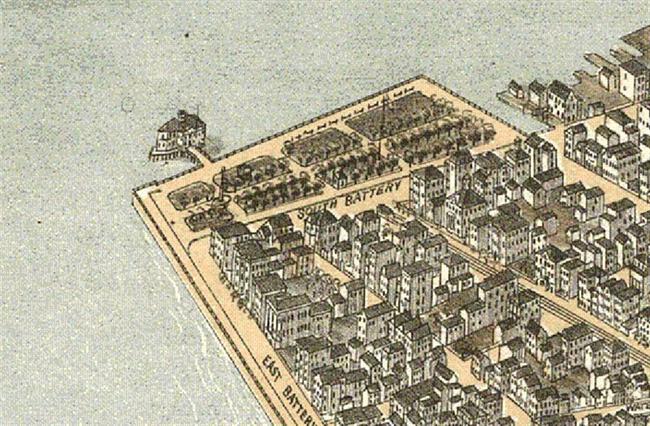"The most fearful gale in this city since 1854," the hurricane of September 28, 1874, lasted only a few hours but left Charleston heavily damaged. Stiff winds and rain began sometime before midnight, and by daybreak it was "evident that the gale was upon us." Winds reached hurricane force around nine o'clock in the morning.
At the height of the storm, roofing slates and tin filled the air; high tide inundated streets near the waterfront, making them impassible. Ignoring the danger, hundreds of people raced down to White Point Garden, following a rumor of imminent tragedy. The frantic report was accurate: the footbridge leading to the public bath house had washed away, the flimsy building was rocking wildly on its pilings, and the proprietor and his family were inside. After several attempts to rescue them by boat had failed, "Mrs. McManmon and her two little children stood at the open window with arms outstretched…" Finally, Harry Hansen, a young serviceman stationed in Charleston, fastened a line to his waist and battled his way to the structure. He pulled over a rope and several life preservers, then made the return trip with the McManmons' daughter just before the eye of the storm passed through. During this brief calm, men rowed two boats to the bathing house and brought all four of its occupants back to the Battery. When the back side of the hurricane struck a few moments later, the bath house slipped off its foundation and sank.
Thousands of spectators visited Charleston's riverfronts on September 29, eager to view the destruction. They found the High Battery, "that magnificent flag-stoned walk, probably the most enchanting promenade of the kind in the country," a broken heap, its paving stones torn loose and hurled into the street. Nothing remained of the bath house, "save a rickety crumbling ruin and the stumps of the posts upon which it was built."
Along the Cooper River wharves were unforgettable scenes. Two tugboats spent several hours extricating the British bark Belgium, which had landed on the dock of North Atlantic Wharf. At Accommodation Wharf, the upper floor of a two-story brick office occupied by Campbell, Wylly & Co. had broken cleanly where the huge bowsprit of a bark had driven into it; a lighter loaded with phosphate rock was thrown up onto the piers of Vanderhorst and Commercial wharves, one end resting on each.
News and Courier beginning September 29, 1874.
Fraser, Walter J., Jr. Lowcountry Hurricanes. Three Centuries of Storms at Sea and Ashore. Athens: The University of Georgia Press, 2006.
Rubillo, Tom. Hurricane Destruction in South Carolina: Hell and High Water. Charleston: The History Press, 2006.


 Wharves1872_650x650.jpg)
 north-commercial-wharf1878_650x650.jpg)
 Wharves1883_650x650.jpg)